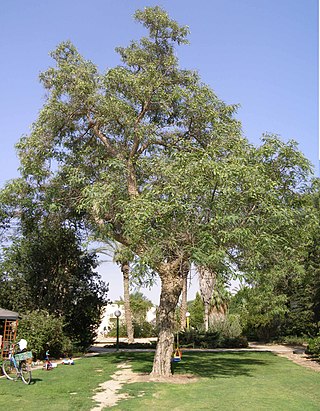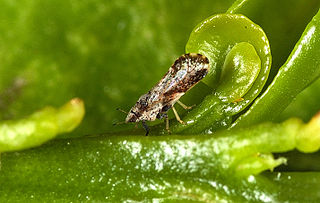Related Research Articles

Hemiptera is an order of insects, commonly called true bugs, comprising over 80,000 species within groups such as the cicadas, aphids, planthoppers, leafhoppers, assassin bugs, bed bugs, and shield bugs. They range in size from 1 mm (0.04 in) to around 15 cm (6 in), and share a common arrangement of piercing-sucking mouthparts. The name "true bugs" is often limited to the suborder Heteroptera.

Whiteflies are Hemipterans that typically feed on the undersides of plant leaves. They comprise the family Aleyrodidae, the only family in the superfamily Aleyrodoidea. More than 1550 species have been described.

Psyllidae, the jumping plant lice or psyllids, are a family of small plant-feeding insects that tend to be very host-specific, i.e. each plant-louse species only feeds on one plant species (monophagous) or feeds on a few closely related plants (oligophagous). Together with aphids, phylloxerans, scale insects and whiteflies, they form the group called Sternorrhyncha, which is considered to be the most "primitive" group within the true bugs (Hemiptera). They have traditionally been considered a single family, Psyllidae, but recent classifications divide the group into a total of seven families; the present restricted definition still includes more than 70 genera in the Psyllidae. Psyllid fossils have been found from the Early Permian before the flowering plants evolved. The explosive diversification of the flowering plants in the Cretaceous was paralleled by a massive diversification of associated insects, and many of the morphological and metabolic characters that the flowering plants exhibit may have evolved as defenses against herbivorous insects.

Scale insects are small insects of the order Hemiptera, suborder Sternorrhyncha. Of dramatically variable appearance and extreme sexual dimorphism, they comprise the infraorder Coccomorpha which is considered a more convenient grouping than the superfamily Coccoidea due to taxonomic uncertainties. Adult females typically have soft bodies and no limbs, and are concealed underneath domed scales, extruding quantities of wax for protection. Some species are hermaphroditic, with a combined ovotestis instead of separate ovaries and testes. Males, in the species where they occur, have legs and sometimes wings, and resemble small flies. Scale insects are herbivores, piercing plant tissues with their mouthparts and remaining in one place, feeding on sap. The excess fluid they imbibe is secreted as honeydew on which sooty mold tends to grow. The insects often have a mutualistic relationship with ants, which feed on the honeydew and protect them from predators. There are about 8,000 described species.

In biology, a lerp is a structure of crystallized honeydew produced by larvae of psyllid bugs as a protective cover. These animals are commonly referred to as lerp insects, of which there are over 300 species in Australia.

Colophospermum mopane, commonly called mopane, mopani, balsam tree, butterfly tree, or turpentine tree, is a tree in the legume family (Fabaceae), that grows in hot, dry, low-lying areas, 200 to 1,150 metres in elevation, in the far northern parts of Southern Africa. The tree only occurs in Africa and is the only species in genus Colophospermum. Its distinctive butterfly-shaped (bifoliate) leaf and thin seed pod make it easy to identify. In terms of human use it is, together with camel thorn and leadwood, one of the three regionally important firewood trees.

Citrus greening disease is a disease of citrus caused by a vector-transmitted pathogen. The causative agents are motile bacteria, Liberibacter spp. The disease is vectored and transmitted by the Asian citrus psyllid, Diaphorina citri, and the African citrus psyllid, Trioza erytreae, also known as the two-spotted citrus psyllid. It has no known cure. It has also been shown to be graft-transmissible. Three different types of HLB are currently known: the heat-tolerant Asian form, and the heat-sensitive African and American forms. The disease was first described in 1929 and first reported in China in 1943. The African variation was first reported in 1947 in South Africa, where it is still widespread. Eventually, it affected the United States, reaching Florida in 2005. Within three years, it had spread to the majority of citrus farms. The rapid increase in this disease has threatened the citrus industry not only in Florida, but the entire US. As of 2009, 33 countries have reported HLB infection in their citrus crop.

Schinus terebinthifolia is a species of flowering plant in the cashew family, Anacardiaceae, that is native to subtropical and tropical South America. Common names include Brazilian peppertree, aroeira, rose pepper, broadleaved pepper tree, wilelaiki, Christmasberry tree and Florida holly. The species name has been very commonly misspelled as ‘terebinthifolius’.

Tipuana tipu, also known as tipa, rosewood and pride of Bolivia, is a South American tree.

The brown marmorated stink bug is an insect in the family Pentatomidae, native to China, Japan, Korea and other Asian regions. In September 1998 it was collected in Allentown, Pennsylvania, where it is believed to have been accidentally introduced. The nymphs and adults of the brown marmorated stink bug feed on over 100 species of plants, including many agricultural crops, and by 2010–11 had become a season-long pest in orchards in the Eastern United States. In 2010, in the Mid-Atlantic United States, $37 million in apple crops were lost, and some stone fruit growers lost more than 90% of their crops. Since the 2010s, the bug has spread to the nation of Georgia and Turkey and caused extensive damage to hazelnut production. It is now established in many parts of North America, and has recently become established in Europe and South America.
Aphalara itadori, the Japanese knotweed psyllid, is a species of psyllid from Japan which feeds on Japanese knotweed.

Diaphorina citri, the Asian citrus psyllid, is a sap-sucking, hemipteran bug in the family Psyllidae. It is one of two confirmed vectors of citrus greening disease. It has a wide distribution in southern Asia and has spread to other citrus growing regions.

Monophlebidae is a family of scale insects commonly known as the giant scales or monophlebids. They occur in most parts of the world but more genera are found in the tropics than elsewhere.

Phylloxeridae is a small family of plant-parasitic hemipterans closely related to aphids with only 75 described species. This group comprises two subfamilies and 11 genera with one that is fossil. The genus type is Phylloxera. The Phylloxeridae species are usually called phylloxerans or phylloxerids.

The spotted lanternfly is a planthopper indigenous to parts of China and Vietnam. It has spread invasively to Japan, South Korea, and the United States. Its preferred host is tree of heaven, but it infests economically significant plants including soybean, grapes, stone fruits, and Malus spp. In its native habitat, L. delicatula populations are regulated by parasitic wasps.

Tamarixia radiata, the Asian citrus cyllid parasitoid, is an hymenopteran wasp from the family Eulophidae which was discovered in the 1920s in the area of northwestern India (Punjab), now Pakistan. It is a parasitoid of the Asian citrus psyllid, an economically important pest of citrus crops around the world and a vector for Citrus greening disease.
Calinda muiscas is a species of jumping plant lice of the genus Calinda in the family of Triozidae. The species was first described in 1997 by Olivares and Burckhardt.
Deraeocoris brevis is a species of predatory plant bug in the family Miridae. It is native to North America where it feeds on plant pests in apple and pear orchards.
Spanioneura fonscolombii, is a species of plant-parasitic psyllid in the family Psyllidae which feed on box. It was first described by Arnold Förster in 1848 and is found in Europe. It is also found in the United States of America where it was accidentally introduced.
Liadopsyllidae is an extinct family of hemipteran insects belonging to Psylloidea ranging from the Early Jurassic to Upper Cretaceous. The family was named by Andrey Vasilyevich Martynov in 1926. They are the earliest known members of Psylloidea, with modern members of the group not known until the Paleogene, as such, they have been suggested to be a paraphyletic assemblage ancestral to modern psylloids. The family Malmopsyllidae has been subsumed into this family, but is considered distinct by some authors.
References
- 1 2 3 4 5 Rung, Alessandra; Arakelian, Gevork; Gill, Ray & Nisson, Nick (25 Sep 2009). "Platycorypha nigrivirga Burckhardt (Hemiptera: Sternorrhyncha: Psylloidea), tipu psyllid, new to North America". Insecta Mundi. 0097: 1–5. Retrieved 18 March 2019.
- ↑ Rung, Alessandra (2009). "Platycorypha nigrivirga Burckhardt (Hemiptera: Sternorrhyncha: Psylloidea), tipu psyllid, new to North America" (PDF). centerforsystematicentomology.org. Retrieved March 18, 2019.
- 1 2 "Tipu psyllid, Platycorypha nigrivirga". University of California, Riverside Center for Invasive Species Research. Retrieved 18 March 2019.